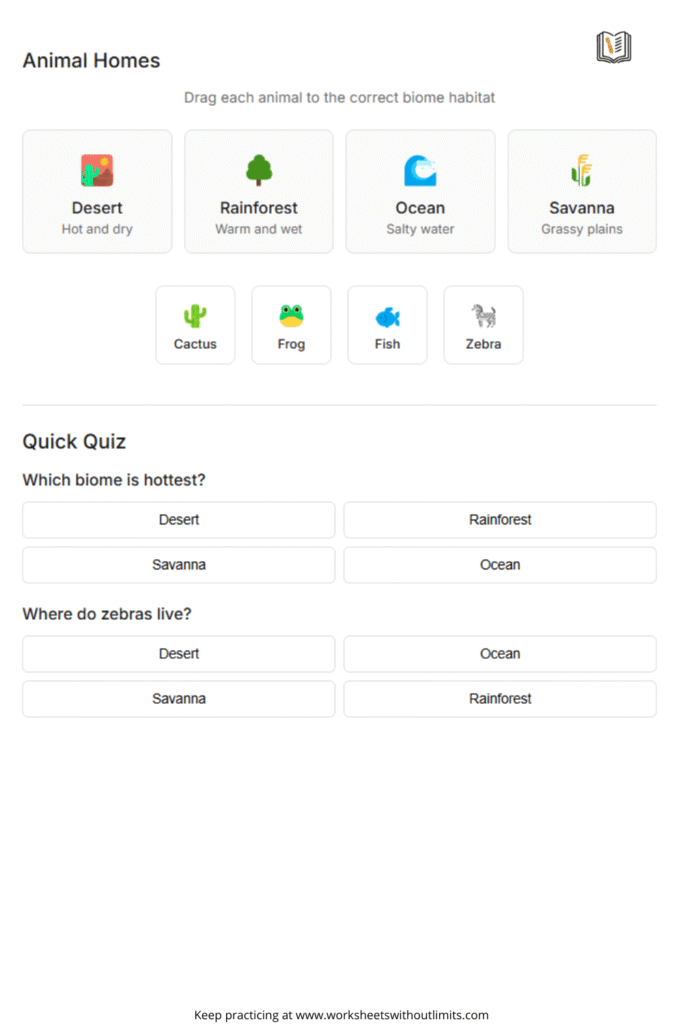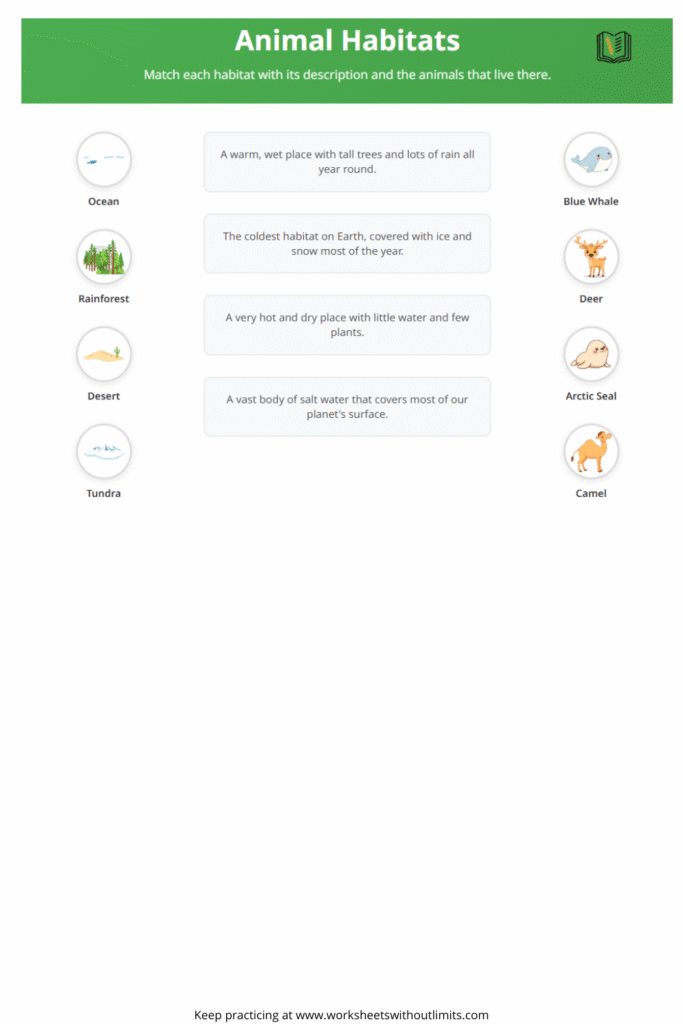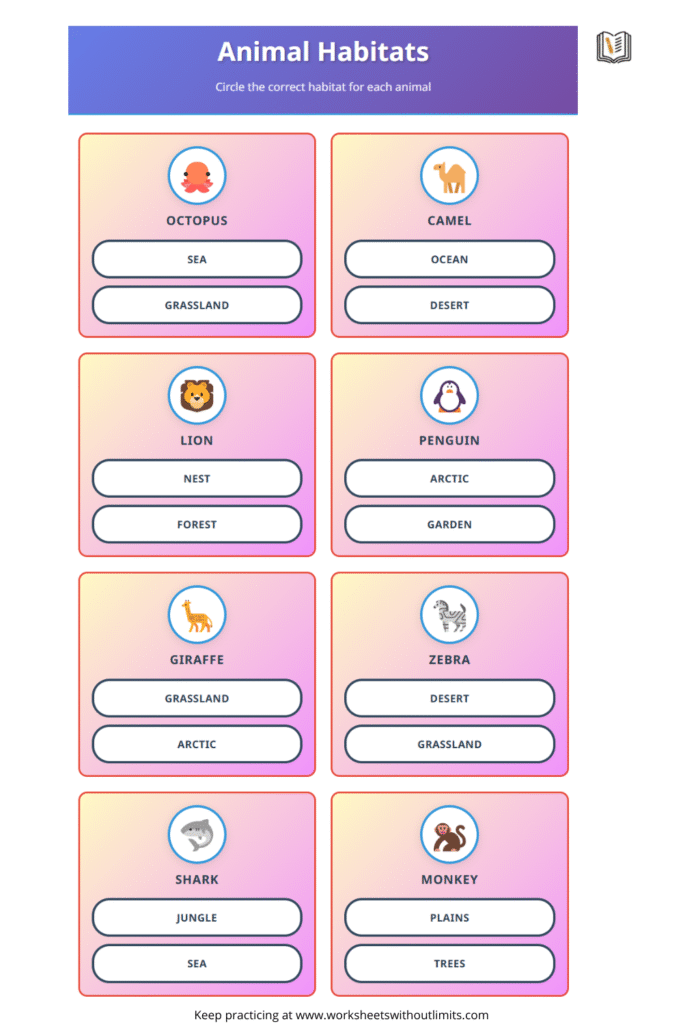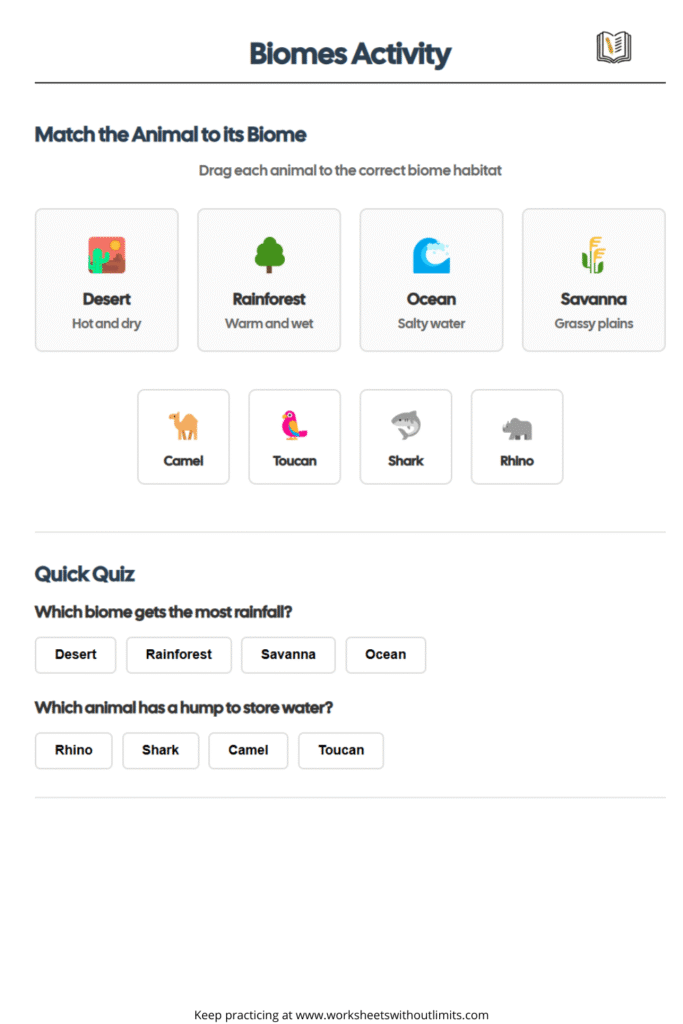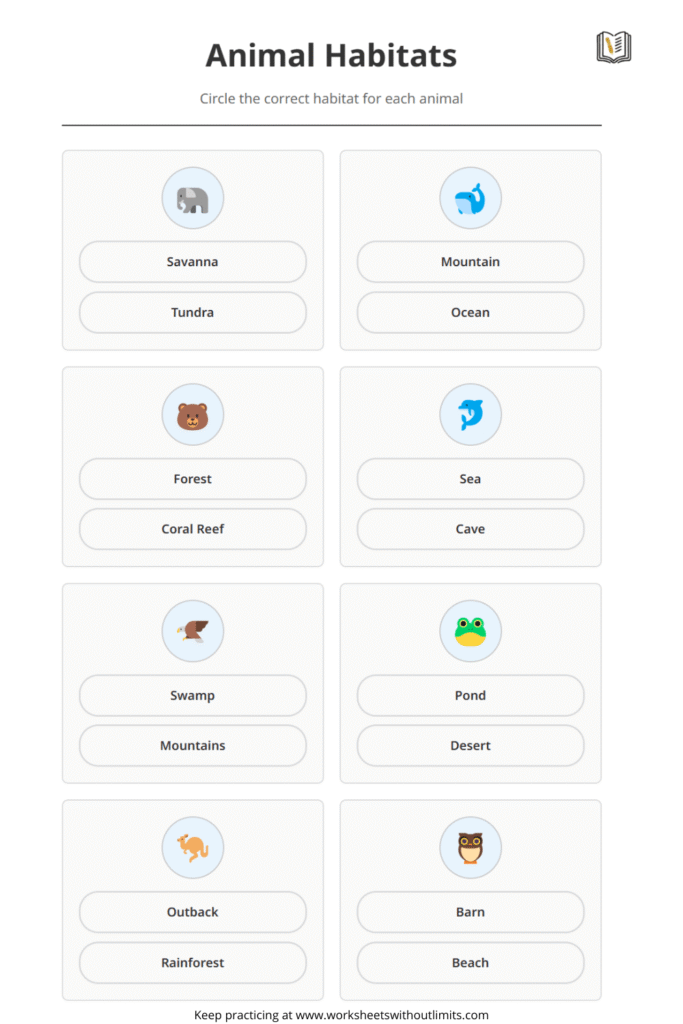Looking for unlimited animal habitats worksheets that are printable, interactive, and ready for classroom or home use? You’re in the right place. Here, you’ll find a wide variety of science exercises covering animal habitats, animal life cycles, and animal needs, all designed to be easy to use and aligned with early science learning goals.
Students can work through the materials online or offline—each worksheet comes with clear instructions, engaging visuals, and answer keys for quick feedback. Whether you're a teacher planning a unit or a parent supplementing schoolwork, these resources offer consistent, meaningful practice.
Habitat Matchers
Habitat Matchers
Connect each animal to where it lives
Click an animal, then click its habitat
What Are Animal Habitats?
An animal habitat is the natural environment where an animal lives and meets its basic needs—food, water, shelter, and space. Different types of animals live in different types of habitats, such as forests, deserts, oceans, grasslands, and wetlands.
Our animal habitats worksheets are built to help young learners:
- Identify different types of habitats
- Match animals to their correct environments
- Understand how animals adapt to survive in their specific habitats
In addition to that, we also cover related science themes like:
- Animal life cycles
- What animals need to survive
- Simple classification of animals by habitat
These concepts provide students with a more complete understanding of the natural world and how living things interact with their environment.
Why Do Students Study Animal Habitats?
Learning about animal habitats and related topics is one of the most engaging parts of early science. Kids are naturally curious about animals, and this topic allows them to explore that interest while developing essential scientific skills.
Here’s why it matters:
- Supports observation and inquiry: Students learn to ask questions about how and why animals live where they do.
- Introduces ecology and life science: Understanding the relationships between animals and their environments sets the stage for more complex biology in later grades.
- Reinforces classification skills: Grouping animals by habitat, traits, or life cycle stages helps develop sorting and reasoning abilities.
- Connects to environmental awareness: Teaching kids about habitats builds early respect for ecosystems and conservation.
Plus, these topics are fun and visual, making them perfect for hands-on lessons supported by animal habitats worksheets and animal life cycle worksheets.
What Students Are Expected to Learn
By the end of an animal habitats unit, students typically should be able to:
- Identify common habitats such as ocean, desert, forest, and arctic.
- Match animals to their appropriate habitats and explain why.
- Describe basic animal needs (food, water, shelter, air) and how those needs are met in specific environments.
- Understand the life cycle of an animal, including stages like birth, growth, reproduction, and death.
- Compare life cycles of different animals and recognize similarities and differences.
Our animals worksheets are designed to gradually introduce and build upon these concepts, with age-appropriate language and visuals.
Tips for Teaching Animal Habitats and Life Cycles
Whether you're teaching this unit in a classroom or supporting learning at home, here are a few ways to make the most of your animal habitats worksheets:
- Use real-world visuals: National parks, zoos, or animal documentaries can bring habitats to life.
- Incorporate storytelling: Let students imagine they are an animal moving through its habitat, facing challenges, and adapting to survive.
- Include hands-on activities: Dioramas, habitat sorting games, or outdoor observation walks help solidify understanding.
- Ask guiding questions: “Why do polar bears live in cold places?” or “What would happen if a desert animal lived in a forest?”
- Tie it to writing and art: Students can draw life cycle diagrams or write about an animal’s day in its habitat.
Our animal needs worksheet and life cycle of an animal worksheet options are ideal for this kind of cross-subject integration, offering simple prompts and structured tasks that encourage deeper thinking.
What's Inside Our Worksheets?
The animal habitats worksheets you’ll find here come in a variety of formats, including:
- Matching activities: Match animals to the correct habitat
- Cut-and-paste tasks: Sort animals or life cycle stages
- Fill-in-the-blank: Use science vocabulary in context
- Labeling diagrams: Identify parts of a life cycle or habitat
- Short reading passages: With comprehension questions about specific animals and their needs
We also offer animal life cycle worksheets that cover the butterfly, frog, chicken, and other familiar examples, as well as worksheets focused on animal needs like food, shelter, water, and air.
All materials are easy to print, cleanly formatted, and ready for reuse. They work well in both independent work settings and group instruction.
Free Printable Educational Worksheets
At the bottom of this page, you’ll find downloadable PDF versions of our full animals worksheet collection. These resources are ideal for:
- Elementary science units
- Homework or practice packets
- Sub plans
- Small group or intervention
- Homeschooling
- ESL science instruction
Each worksheet includes student instructions and, where applicable, answer keys for quick feedback. Print just the ones you need or download the full set for ongoing practice throughout the year.
Whether you're focusing on one animal at a time or teaching full lessons on ecosystems, these printables offer a strong foundation.
Practice Anywhere, Anytime
The beauty of these animal habitats worksheets is their flexibility. Use them:
- As warm-ups or exit tickets
- In science centers
- After watching a documentary or reading a nonfiction book
- As part of a cross-curricular unit (with reading, writing, or art)
- In one-on-one tutoring sessions
Because the activities are simple and adaptable, you can adjust the difficulty level depending on your students' age or reading skills.
And since everything is available as unlimited practice, you can revisit the same concepts again with fresh material or reinforce learning through repetition without running out of options.
Find all the educational worksheets on our Pinterest account.

